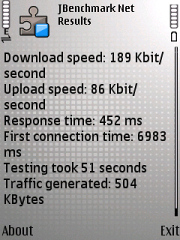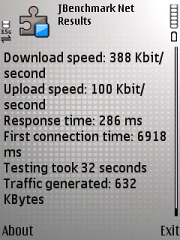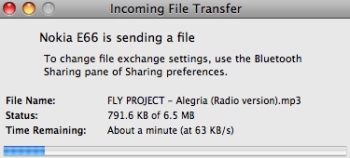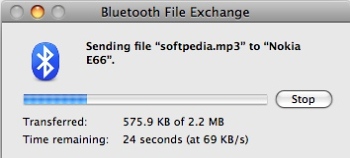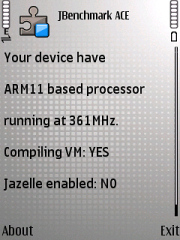Nokia's Eseries is one of the most appealing handset line-ups, which targets businessmen on the go. Usually, those interested in such business devices aren't looking for any 'wow' factor or high-specs like excellent music sound or high quality camera, but prefer to have a wide range of email options and good data transfer speeds. Lately, Nokia offered these users new devices, which feature a very cool design, as a bonus. Nokia E71 and E66 are just two examples proving that the Finnish giant started to care about how good its business phones look. Those of you who didn't get the chance to read E71's review can read this one and won't miss too much except maybe in terms of design. Both Eseries handsets, E71 and E66, were announced and launched at the same time, and feature almost similar technical specifications.
Announced in June 2008, Nokia E66 was effectively launched on the market one month later, in July 2008, together with its E71 brother. The E66 slider can be acquired for around USD 400$ unlocked and with a 2GB microSD card included in the sales package. Potential buyers can opt for any of the two colors available: White Steel and Grey Steel.
Design
Nokia E66 features a slider form, but looks rather strange as the upper part of the phone is much shorter than the bottom part. This is the only trait that differentiates E66 from other sliders, in terms of design. Even if the innovation may catch the eye of some users, others might not like it at all. I simply consider it strange looking, but rather useful as it makes the phone sliding mechanism easier to use. Otherwise, you get the same slider touch as with all other Nokia sliders, except that this one doesn't feel cheap at all. The back of the phone is all covered in metal, as well as the display's frame. What's left of the phone is made from a sturdy shiny plastic, which feels rich and stylish. The medium sized display is covered by scratch resistant glass, which seems to keep fingerprints away. Still, it fails to keep the screen clean from grease and it will soil easily after you talk on the phone. Often wipes will be needed.
E66 measures 107.5 x 49.5 x 13.6 mm and weighs 121g (including battery), which places it in the medium-sized sliders category. Above the display, one can notice that the slider features a secondary camera for video-calls, as well as a light ambient sensor. Bellow, the D-pad is surrounded by the Symbian specific keys, which can only be seen when the backlighting is ON: Menu key, Contact key, Organizer key and Email key. The last row of keys includes a Delete key and the two Accept and Reject calls keys.The right side of the phone has been gifted with lots of external buttons such as: Voice tag, two volume keys (up/down) and Camera key. On the left side, there's a 2.5mm jack port for headphones and a microUSB port, but also an Infrared port. The bottom of the slider includes the charging port, while on top, impossible to miss, is the power button, which looks annoyingly out of the picture with its red color.
The keypad layout is standard for any up to date handset and doesn't include anything out of the ordinary. Keys are large and very easy to text with. In fact, this is one of the great advantages of the slider. Even if there's such a small place left for the keypad, Nokia managed to 'crowd' the keys in such a way that texting is a breeze. Of course there's a big difference between E71's QWERTY keyboard and E66's standard keypad, but this won't be felt too hard.The battery cover on the back of the phone is made from stainless steel, which protects the slider from drops. Unfortunately, the 3.2 Megapixel camera on the back has been left unprotected, so any drop on the back of the phone might have disastrous after-effects. Near the camera, there's also a medium-sized flash that helps with night pictures, as well as a self-portrait mirror. Strangely, the loudspeaker has been placed near the left corner, almost on the bottom of the device. If you keep the phone with your right hand, you'll cover the loudspeaker and sound will suffer, so be careful how you keep it in your hand if you intend to listen to music.
Overall, Nokia has done a good job, the slider mechanism is pretty sturdy, the stylish trait is secured by the stainless steel cover and the polished plastic used for manufacture. Just like E71, its slider brother makes a good addition in terms of design to the Eseries portfolio.Display and Camera
Nokia E66 features a 2.4'' TFT display, which seems to be exactly 0.4'' larger than E71's. I wouldn't have noticed, as E71 features another kind of resolution, but these are the real numbers. The TFT screen supports 16 Million colors and 240x320 pixel resolution. Moreover, the slider has been gifted with a very fine accelerometer sensor for auto-rotate. Anyway, images are showing great on the display and it performs very well under bright sunlight. For performance, please check the benchmark results below.
The 3.2 Megapixel camera features flash, autofocus capabilities and 4x digital zoom. Unfortunately, these are the only good points worth mentioning, as the camera fails to impress and only takes below average quality pictures. Just like E71's camera, this one is surely designed for businessmen that don't need good picturing capabilities. At least, E66 features a dedicated camera key, which makes the autofocus function easier to use. Otherwise, the camera interface is standard for Symbian devices and includes: White Balance, Colors, Exposure compensation, ISO sensitivity and Gridline. As you can see from the picture samples, snapshots miss contrast, colors seem a little dull, while a massive quantity of noise affects almost every picture. Video capabilities are also limited, the slider can only record movies in QVGA mode at 15fps, and their quality is even worse than that of the pictures. Overall, camera function is not something you would want to use frequently with E66 slider. I bet most businessmen would've preferred the E66 without camera, but then you wouldn't have the video-call capabilities, so Nokia made a compromise.Menu and Software
Just like E71, Nokia E66 runs Symbian 9.2 operating system, with S60 3rd Edition and Feature Pack 1 interface. This Pack offers several improvements and adds some new features, like an alarm clock, vCalendar 2.0, support for 3D graphics and hardware acceleration, as well as screen turning. The repeated alarm clock provides users with the wake up call whenever they want so they don't have to buy third party applications for that purpose.
The main menu can be accessed by pressing the Menu key ('House' icon), next to the D-pad controller. In addition to the usual options and applications that we find in almost all Symbian-powered handsets, Nokia E66 features Search and Maps utilities. Maps is used together with the GPS receiver and enables owners to use Nokia maps, localization and directions when they're on the go. Lots of maps can be downloaded from Nokia's website and then used to pick the shortest route from one point to another. Under the Office category, we find QuickOffice applications used for reading Word, Excel and PowerPoint files. Buying a license is required for editing these files. There's also a complex calendar, a dictionary, a PDF reader, a Notepad, a Zip archivator, a calculator, a currency converter, a voice recorder (active notes), a file manager, printers and support for wireless keyboard. All applications pre-installed or third party apps installed after buying the device are placed in the Installations sub-menu. It offers some interesting applications such as: Multiscanner (Card reader), Advance Call Manager, Sports Tracker, WiPresenter, WorldMate, Yahoo!Go.The phone includes everything a businessman may need on the road or at the office, pre-installed on the handset: email, web, calendar, organizer, IM, office tools, messaging, applications manager, connectivity wizard, synchronization tools, GPS navigator, themes, profiles, and even more.
The media sub-menu is comprised of utilities present in almost all Symbian-based devices: Recorder, Music player, Gallery, RealPlayer, Podcasting, Radio, Flash Player, 3-D tones, Music store. When accessing the Tools section of the menu, one can discover some goodies that are not specific to Eseries devices: Switch (transfers content, such as contacts, from a compatible Nokia device to the E66 handset using Bluetooth or Infrared), Encryption, Modes (changes one home screen to another customized screen), Voice aid, Barcode reader.Comparing E66 with E71 I have found the latter being much faster, while the first features a very cool 'fading' effect every time you browse thorough the menu. I have also noticed some problems with the Maps function when using the E66 with 100.07.78 firmware, like freezing. Fortunately, all bugs were solved once I updated to 110.07.126 firmware.
Communications
Nokia E66 is a quad band GSM (850 / 900 / 1800 / 1900) handset, HSDPA 900 / 2100 (3.6 Mbps) compatible, which features GPRS class 32 (100 kbps), EDGE 32 class (296 kbps), High-Speed Circuit-Switched Data (57.6 kbps) and Wi-Fi 802.11 b/g. Tested on the EDGE and 3G networks, the phone performed a little bit above average, as you can also see in the screenshots.
The WLAN wizard helps you search and define your WLAN network connection settings. If you want to connect to the Internet, you must first define an Access point (EDGE, WLAN or 3G). You can do that by going to Main menu - Tools - Settings - Connection - Access points, and define which access point is to be used whenever a network connection is required (Main menu - Home network – Settings). Other connectivity tools include Bluetooth 2.0 with A2DP and EDR support, and microUSB for PC synchronization (no charging). The Bluetooth connection reached almost 63 KB/s when sending files and 69 KB/s when receiving, which is a little bit lower than I was expecting. When connecting the USB cable, you'll be able to choose among four modes: PC Suite, Mass storage, Media transfer, Connect PC to Web. All four modes are intuitive and easy to use, so there's nothing more to add here. Thanks to the microUSB port, the synching process is easy to attain. Unfortunately, I have experienced problems with synchronization, like the phone disconnecting pretty frequently when I tried to access it. This is definitely a software problem, which I believe Nokia will solve pretty soon.The built-in GPS receiver features the A-GPS function, which makes localization even faster. I tested the phone and I didn't have any trouble with satellite signal. The GPS located my position in about two minutes and the strength of the signal was above average. It worked flawlessly in conjunction with the Nokia Maps.
In terms of messaging, the phone offers a complete solution accepting all available message types. Furthermore, given the fact that it misses a QWERTY keyboard, it might take a while to get used to the standard keypad when writing long emails. Still, I believe E66 features one of the best keypads meant for texting, so the lack of QWERTY won't be a problem. The phone includes no less than four message editors, one for each type: SMS, MMS, audio message and e-mail. The message client works with POP3, SMTP, and IMAP4 protocols, and supports more than one email account. Also, it can download headers and supports attachments. VoIP support is also a good addition to the communication department.
The quad-band (GSM 850 / GSM 900 / GSM 1800 / GSM 1900) network compatible handset has a very good GSM signal reception. Unfortunately, the UMTS signal reception is only at half strength, so I don't recommend accessing it unless you intend to use the phone to browse the Internet or to make data transfers. The sound is above average in quality at both ends, and pretty loud. The vibration alert is also above average in intensity, so you don't really need to set it to higher levels.Processor and Memory
Both E71 and E66 are powered by the same kind of CPU – ARM11 369 Mhz. As stated above, E66 is a little bit slower than E71.
I believe the main reason is the 'fading' effect embedded into the E66 firmware, which simulates the slide-show capabilities. Still, for a business phone, it is acceptable and won't make too much of a difference. In terms of memory, Nokia E66 includes 110 MB internal storage memory and 128 MB SDRAM memory. Besides the 2GB microSD card that comes with the phone, you'll be able to expand the storage space up to 8GB. The only drawback is the fact that the slot card has been placed under the back cover of the phone.Multimedia
Nokia's Eseries is not renowned for its multimedia features, E66 falling in the same category. Regardless of the fact that you get all the possible media features that a businessman might need, we really cannot talk about high-end quality. Still, you get a nice music player that supports AAC, AAC+, eAAC+, MP3 and WAV music file formats. It features Equalizer (Bass booster, Classical, Jazz, Pop, Rock and Default), Balance, Loudness and Stereo widening. Files can be automatically sorted by artist, genre, and album.
The integrated FM Radio can record up to 50 base stations and features the Visual Radio functions. Reception is very good, but sound is a little bit of a let-down if you don't change the HS-47 stereo headset that comes with the phone. The same goes for the music player sound, but don't expect too much quality even with good headphones. The Bluetooth 2.0 with A2DP support enables users to listen to music wirelessly. The phone lacks a YouTube client, but movies can be seen with the integrated RealMedia player. You can forward, rewind, pause the clips, or can choose to see the movies in full screen. There's also a Flash player that recognizes .swf files.Battery
The 1000 mAh Li-Polymer (BL-4U) battery has an officially stated life expectancy of 264 hours in standby and of about seven hours and a half in talk time mode. Unfortunately, the true numbers are nowhere near the official ones, with around three hours and a half of talk time. The phone drains the battery much faster than it should, so I believe there's a software issue, which should be corrected.
Impressions
At first glance, there isn’t too much chemistry between Nokia E66 and I. I learned to love the slider only after using it for a while and seeing how many things it can do and how good they're done. In case you're searching for a slider business phone, Nokia E66 is the best solution at the moment. If you hate sliders, then E71 can take E66's place with ease.
The Good
The Bad
Sales package
Nokia E66 handset Nokia battery BL-4U, 1000 mAh Nokia Compact Travel Charger AC-5 Nokia Stereo Headset HS-47 Nokia Connectivity Cable CA-101 Nokia 2GB microSD Card MU-22 Eseries general CD-ROM Eseries Wrist strap Eseries Pouch Eseries Leaflet Quick Start Guide.
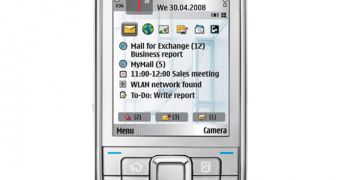
 14 DAY TRIAL //
14 DAY TRIAL // 






















































